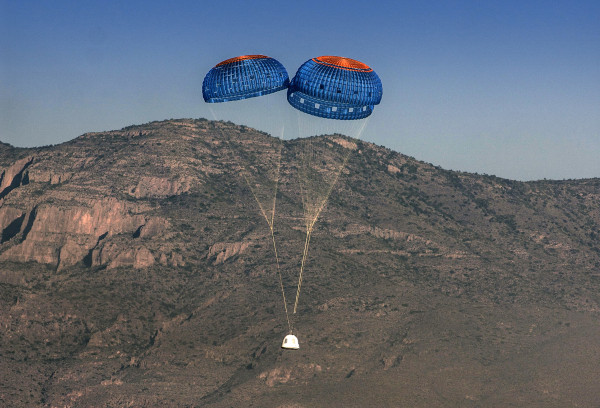 Michael Belfiore
Michael Belfiore
IPFS
Blue Origin reaches space in a reusable vehicle
Written by Michael Belfiore Subject: Space Travel and ExplorationYesterday at Blue Origin's West Texas proving grounds, the company's New Shepard spacecraft launched to an altitude of 329,839 feet, almost 2,000 feet past the international accepted boundary of space, and returned to Earth to complete a "flawless mission," in the words of company founder Jeff Bezos in a press release that I received early this morning.
This is the first time that a reusable spaceship designed to carry humans has reached space since 2004, when SpaceShipOne proved that manned flight by a privately built vehicle is possible.
Bezos, who also runs online retail and cloud computing giant Amazon, eschews the publicity sought by his main rival in the private suborbital space race, Richard Branson's Virgin Galactic. Instead, he prefers to announce only major successes on the way toward his vision for manned spaceflight, and he rarely grants interviews.
New Shepard is an autonomous, single stage rocket fueled by a single Blue Origin-designed-and-built BE-3 liquid hydrogen and liquid oxygen fuel engine.
Following yesterday's launch, which took place at 11:21 a.m. Central Time, according to the press release, New Shepard rocketed to high altitude at 3.72 times the speed of sound carrying a crew capsule, which was unmanned for the test.
 After separating from the rocket, the crew capsule coasted to an apogee of 329,839 feet, half a kilometer past the 100-kilometer Karman line that marks the generally-accepted boundary of space. After a flight through space, during which any astronauts on board would have experienced a few minutes of microgravity, the capsule reentered the atmosphere. At 20,045 feet, the capsule deployed a trio of parachutes to make a gentle landing on the desert floor below.
After separating from the rocket, the crew capsule coasted to an apogee of 329,839 feet, half a kilometer past the 100-kilometer Karman line that marks the generally-accepted boundary of space. After a flight through space, during which any astronauts on board would have experienced a few minutes of microgravity, the capsule reentered the atmosphere. At 20,045 feet, the capsule deployed a trio of parachutes to make a gentle landing on the desert floor below.
Meanwhile, the booster rocket fell Earthward in controlled flight enabled by eight drag brakes and hydraulically actuated steering fins, according to a blog post by Bezos.
The rocket reignited its engine at 4,896 feet and touched down just a few feet from the center of a landing pad on the ground.
 "Now safely tucked away at our launch site in West Texas is the rarest of beasts—a used rocket," said Bezos in the press release. "Full reuse is a game changer, and we can't wait to fuel up and fly again."
"Now safely tucked away at our launch site in West Texas is the rarest of beasts—a used rocket," said Bezos in the press release. "Full reuse is a game changer, and we can't wait to fuel up and fly again."
He's right, and now Blue Origin has the only reusable suborbital vehicle in the world capable of carrying astronauts to space.
The ship's first mission will be to fly paying passengers into the black sky of space for views of the curvature of the Earth and the thin blue line of the atmosphere and the experience of weightlessness that Virgin Galactic has been promising for 11 years now.
Virgin hired SpaceShipOne's builder, Scaled Composites, to build an eight-seat version of the original three-seat craft, which now hangs beside the Spirit of St. Louis in the most-visited museum on the world, the National Air and Space Museum in Washington.
Unfortunately, the hybrid solid/liquid rocket motor chosen by SpaceShipOne's designer, Burt Rutan, did not scale up well to the larger vehicle, which still has not succeeded in reaching space.
On October 31, 2014, SpaceShipTwo suffered a catastrophic breakup during a powered test flight launched from its home airport in Mojave, California, taking the life of the pilot and injuring the co-pilot, who became the first person to successfully bail out of a moving spaceship. A second SpaceShipTwo is still under construction.
Until recently, my money was on rival company XCOR Aerospace and its own suborbital spaceplane called the Lynx, for getting the first paying passengers into suborbital space. However, earlier this month, that company suffered the departure of three of its four founders and main visionaries. I haven't yet heard why they left, but their departure, which I heard about from a source inside the company, would seem to be a blow to the company and its plans for human spaceflight. The Lynx, too, is still under construction.
That leaves Blue Origin, with its first successful flight to space behind it, number one on the runway for offering the first flights to suborbital space for those who can pay their own way.
The Blue Origin website describes the spaceflight experience that the company will soon offer. It doesn't quote a price or give a date for the first manned flights of the six-seat vehicle.
Bezos's ambitions for Blue Origin are much loftier—ultimately to enable the settlement of space, as this Blue Origin promotional video implies.
Photos and video courtesy of Blue Origin.






























1 Comments in Response to Blue Origin reaches space in a reusable vehicle
Several impressive achievements! Long way to go to get to orbit however. Still, could be offering tourist rides to space fairly soon I would think. Though I assume this time there was no payload aboard.